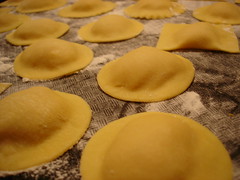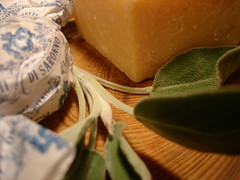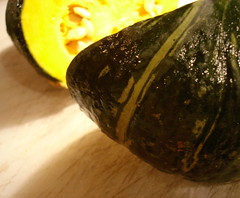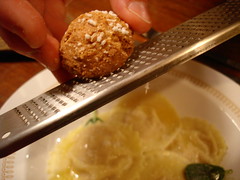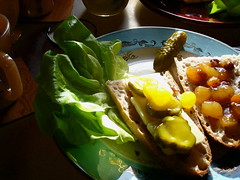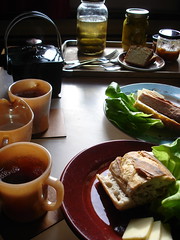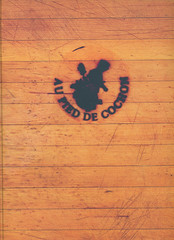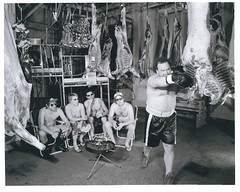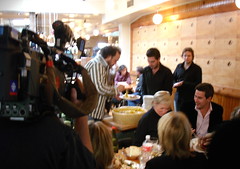Do we go out? Do we stay in? If so, what do we make? What kind of event do we hold? Are we talking brunch? Lunch? Cocktails? Dinner? What exactly is le concept?, as people sometimes put it around these parts.
For us, the Summer of 2006 was synonymous with barbecue. We caught the fever right at the beginning of the summer and our temperature continued to run high for months. In fact, technically, we caught the fever before the summer had even actually begun, and it lasted right through the season and into the fall. We had it so bad, we envisioned GSFC events right up until the end of October. As it turned out, however, the one weekend with great barbecue potential (bright sunshine, blue skies, and unseasonably warm temperatures) was the weekend of Puces Pop when we were otherwise occupied and we never had another opportunity to take it to the streets. So when we started to toss around ideas for our anniversary party, we beat around the bush a little, but all we really wanted was some more barbecue. And with the weather being what it's been (not real pretty, exactly, but mild at least) we even got an opportunity to bust out the gas grill one last time so we could do things properly (well, as properly as you can do things with a gas grill).
We wanted to do something special, so we got it into our heads to invite a shady musical ensemble known only as The Secret Choir to perform, to give our barbecue the feel of a real Sunday gathering (something we'd wanted to do for our final GSFC bbq of the year), but their bass was away on business. So we placed an open call to any and all "sanctified singers" that might be hiding amongst our invitees*, made some gospel mixes as a back-up, and started planning our menu, figuring we'd let the food hog the spotlight.
We trotted out all of the classics from our first North Carolina-style barbecue for this particular event--Eastern North Carolina Pulled Pork Sandwiches, A.J.'s Tangy Piedmont Cole Slaw, Down East Baked Beans, and our smoky Not Quite All-American Barbecue Sauce--but in order to mix things up a little, and because we were going to be operating out of the comfort of our own home, not toughing it out in some public or semi-public space, we tested out a few new recipes. The result was a Sunday barbecue bonanza.
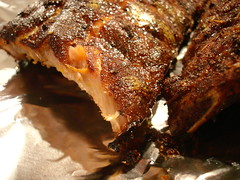 fig. a: MO-style ribs
fig. a: MO-style ribs
MO-style BBQ Ribs
2 full racks of 3/down pork spare ribs [the term “3/down” refers to the weight of the rack. In this case, it means a slab of 10 to 12 ribs that weighs three pounds or less]
rub (1 cup):
2 tbsp salt
2 tbsp sugar
2 tbsp light brown sugar
2 tbsp freshly ground cumin
2 tbsp freshly ground black pepper
2 tbsp chili powder
4 tbsp paprika
basting sauce (2 cups):
1 3/4 cups white vinegar
2 tbsp Tabasco sauce
2 tbsp sugar
1 tbsp salt
1 tbsp freshly ground black pepper
Preheat your oven to 180º F. Rub the ribs with your Missouri-style BBQ rub and allow them to come to temperature (partially, at least), about 1/2 hour. Place the ribs on a large baking sheet and put them in the oven for 3 hours. There’s no need to flip the ribs or disturb them in any way. You’re cooking them at a very low temperature and getting the rub to do its work.
Remove the ribs from the oven. At this point you can either let them stand for a while, cover them and refrigerate them (for anywhere up to 2 days), or slap ‘em on the grill immediately.
When it comes time to grill, you want a very low fire and you want to continue to slow-cook them until your patience won’t hold out any longer. Ideally, a light crust will form over the ribs and you’ll notice caramelization begin to occur. 1/2 hour over your lowest flame should produce excellent results.
If you like your ribs “wet,” coat them with you basting sauce just before removing them from the grill. If you’re a “dry,” as I am, just serve them with your basting sauce on the side.
Serves about 5 people as a meal, or about 20 as a special surprise.
[Based on a recipe from Chris Schlesinger and John Willoughby's The Thrill of the Grill.]
In our case, I heated my gas grill on high until my smoking apparatus filled with water-soaked hickory chips began to give off its hickory perfume. Then I turned down my fire to the very lowest setting and placed my two racks at the outer extremities of my cooking surface, to minimize any chance of overcooking. I let them do their thing for 1/2 hour and then went out to check on them. They’d formed one of the nicest crusts I’d ever seen on home-barbecued ribs.
I brought them into the kitchen, tore off a “test rib” for Michelle and myself, dabbed on a little of the basting sauce, and we sampled the goods. Unreal. We gave each of our 20 guests who stopped by a rib as a surprise. I felt like I was distributing candy.
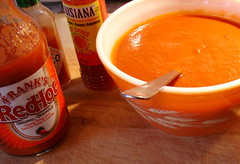 fig. b: fixins bar
fig. b: fixins bar
Poor Man’s Caviar
2 15-oz. cans of black-eyed peas
8 scallions, chopped
1 green bell pepper, finely diced
1 red bell pepper, finely diced
1 large tomato, cored and diced
1/4 cup cilantro
dressing:
2/3 cup extra-virgin olive oil
1/3 cup red wine or sherry vinegar (or a combination of the two)
1 pinch dried herbs, such as basil, oregano, and thyme (or a combination of these)
1 tiny pinch crushed red pepper flakes
salt and freshly ground black pepper to taste
Tabasco sauce
Drain the peas well and place them in a large bowl. Add the other dry ingredients. Mix the salad dressing. Add the salad dressing and mix thoroughly. Season to taste. Add a healthy dash or two to the salad, if so desired.
Cover the bowl with plastic wrap and refrigerate for a minimum of 3 hours and preferably overnight, to allow the flavors to mingle properly. Serve cold or at room temperature.
Makes 8 cups.
I think I was the only one at our barbecue who'd ever even heard of Poor Man's Caviar prior to Sunday. The recipe above is adapted from one we found in Kathryn Eastburn's "The Sacred Feast," the
Saveur article that had been one of the inspirations behind our first GSFC barbecue. The original called for a 16-oz. bottle of store-bought Italian dressing. I didn't have any problems making barbecue sauce with Coca-Cola last
June, but for some reason I couldn't bring myself to buy a bottle of commercial salad dressing. Plus, just because this was a "caviar" dish, I really didn't feel the need to teach those black-eyed peas to swim. I made my own dressing, and I cut the volume in half. It turned out great, with just the perfect amount of dressing.
Sweet Tea à la AEB
Place 4 orange pekoe tea bags in a large jug and fill it with hot water out of the tap. Allow the tea to steep outside overnight. The next day remove the tea bags. Make a simple vanilla syrup by adding 2 cups sugar and 1 vanilla bean to 2 1/2 cups water. Bring to a boil and cook until the sugar dissolves. Add the syrup to the tea to taste, but we found that this amount of syrup was just the perfect amount for our massive 5 L jug. Serve straight or with a slice of lemon. Tastes pretty good with a little bourbon, too.
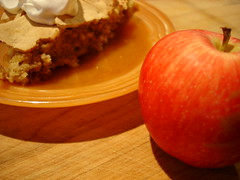 fig. c: Huguenot torte
fig. c: Huguenot torte
Huguenot Torte
3/4 cup ground pecans
3/4 cup ground English walnuts
1/2 cup ground black walnuts
2 medium apples, peeled
4 large egg, at room temperature
1 large egg yolks, at room temperature
1 3/4 cup sugar
3/4 cup unbleached all-purpose flour
16 perfect pecan halves
Sugar
2/3 cup cream
Prepare two 9-inch cake pans by lightly greasing them, lining them with waxed paper or parchment, greasing the paper, and lightly dusting with flour. Preheat the oven to 375 degrees F. and put a pan of water in the bottom of the oven.
Mix the ground nuts together. Very finely chop the apples with a knife. You should have 1 3/4 cups. In a warmed electric mixer bowl, beat the eggs and egg yolk on high speed until doubled in volume. It may take 10 minutes or more. Slowly add the sugar while beating and continue beating until the volume is tripled. The eggs should be very thick and light in color. Don't be afraid of over-beating. Sift the flour over the egg mixture. Sprinkle the ground nuts over all, followed by the apples. With a large spatula, fold the mixture together rapidly but gently, being certain to bring all the elements from the bottom of the bowl up into the mixture. Divide the batter between 2 cake pans and bake in the middle of the oven for about 25 to 30 minutes, or until the top is golden brown and the sides have begun to pull away. Do not push on the meringue like top, or it may cave in. Place on a rack in a draft-free place and let cool completely.
Lightly toast the pecan halves while the cake are in the oven. While the pecans are hot, quickly dip them in water and then roll them in granulated sugar until they are lightly coated. Let them dry on a rack. The cakes must be perfectly cool, or the heat will melt the cream. Invert the pans to remove the cakes, discarding the paper liners, and turn the cakes back over again so that the crusty top surface is in its original position. Place each cake on a serving platter. Using an electric standing mixer, fitted with a whip attachment, whip the cream with some sugar until stiff and place 8 dollops of the cream evenly around each cake. Garnish each bit of cream with a sugared pecan and serve with a shot glass of bourbon neat.
[Adapted from a recipe in Hoppin' John's Lowcountry Cooking: Recipes & Ruminations From Charleston and the Carolina Coastal Plain]
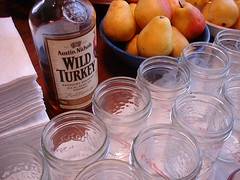 fig. d: sweet tea & bourbon bar
fig. d: sweet tea & bourbon bar
This is one of my favorite desserts (the fact that I supposedly have some Huguenot blood on my maternal side** may have something to do with this), but Michelle had never heard of it. She was a little worried when it finished baking because it wasn't much to look at (like many of the best Southern dishes, desserts included, it's a little on the homely side--wonderfully so), but when she finally got around to testing it out, she was very pleasantly surprised. Meanwhile, Patrice was so impressed he promptly decided to work on a version for Le Chou. If you've never tried it, you really must. It forms a meringue-like crust up top, while below the torte remains soft and spongy and the nuts and apples combine their flavors in a way that's wholly unique and utterly delicious. And if you think the shot of bourbon is purely superfluous, you're wrong.
Postscript: It's now been three days since our barbecue, and any and all leftovers are long gone, but a faint scent of hickory smoke continues to linger in the air, which gives off the uncanny sensation that you've stepped into a fully furnished, all-mod-cons smokehouse. Every time I come home that gentle hickory wind just makes me hungry.
aj
*Apologies to any and all we weren't able to extend an invitation to, especially all of you sanctified singers we might have missed. We much prefer throwing inclusive events, but, hey,
c'est la vie...
**Believe it or not, while Protestant sects were later barred from entering New France, the early history of Quebec was somewhat more tolerant (how else to populate such a remote land?), and a Huguenot presence settled there in the early 17th century. When the tide turned later in the century, much of this population, including some of my ancestors, apparently, was quickly converted to Catholicism. Huguenot Torte is a product of the proud Huguenot population which settled in Charleston, SC following the Edict of Fontainebleau in 1685. I'm not sure if anything similar was ever made in Quebec.
 fig. a: the original Lady Soul
fig. a: the original Lady Soul









